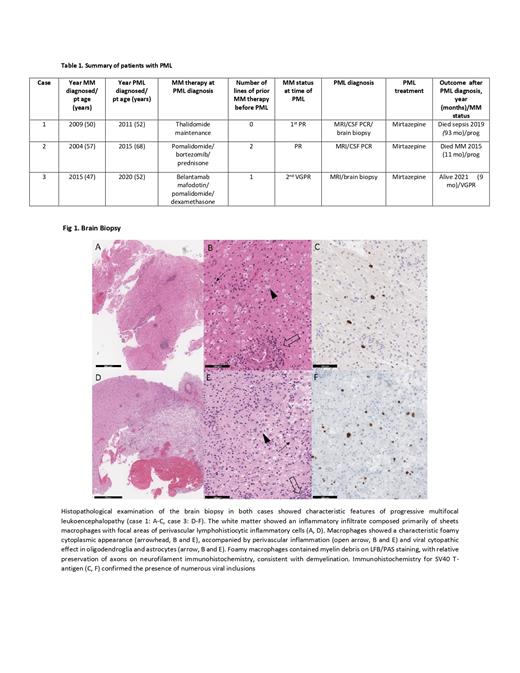Abstract
Introduction
Progressive multifocal leukoencephalopathy (PML), caused by the John Cunningham (JC) virus, is an infection that requires immunosuppression for its manifestations and is fatal disease in many cases. (1) After asymptomatic primary infection, which occurs in childhood, the virus remains quiescent. (1,4) The classical clinical presentation is that of a subacute symptomatology that develops over weeks or months and consists of diverse sensorimotor abnormalities depending on the site of brain involvement. Approximately 22 cases of PML amongst patients with multiple myeloma (MM) have been reported in the literature between 1965 and April 2020. (5)
Methods
We performed a retrospective chart review of all myeloma patients who were treated at the Princess Margaret Cancer Center from 2010-2020 to identify cases of PML. Patient and disease characteristics, responses, and survival outcomes were collected from Myeloma and Stem Cell Transplant databases and electronic patient records under REB approval.
Results
We identified 3 cases of PML in MM patients at our center over the past 10 years, all of which occurred in patients receiving therapy containing an immunomodulatory derivative (IMID), i.e., thalidomide, lenalidomide or pomalidomide.
Patient 1
A 52-year-old male with kappa light chain MM presented in 2009 on hemodialysis and received upfront bortezomib and dexamethasone followed by melphalan 200mg/m 2 and autologous stem cell transplantation (ASCT) in March 2010; maintenance with thalidomide was given until July 2011 when he presented to the ER with left-sided weakness, facial droop, and decreased strength. CT scan showed right-sided hypodensity in keeping with demyelination. PML was confirmed by MRI, lumbar puncture with positive PCR for JC virus, and a brain biopsy (Fig 1 A-C). He was treated with mirtazapine, and also developed status epilepticus controlled with phenytoin and phenobarbital. His myeloma treatment was never resumed after the diagnosis of PML due to concerns about viral reactivation. Approximately 3 years after PML diagnosis, his serum free kappa protein levels started to increase; he remained on hemodialysis but experienced no new myeloma-related organ damage and no myeloma treatment was offered. His last follow-up in clinic was in March 2019. However, he succumbed to S. pneumonia septicemia in July 2019.
Case 2
A 68-year-old female with IgG kappa MM diagnosed in 2004 was treated with high-dose dexamethasone induction followed by melphalan 200mg/m 2 and ASCT and relapsed 2 years later. She commenced cyclophosphamide and prednisone until July 2011 when treatment was changed to lenalidomide and prednisone; subsequent progression in February 2014 was treated with pomalidomide/bortezomib/prednisone. In November 2014, we noticed worsening vision. Brain MRI showed hyperintensity in T2 in the occipital lobe. Her myeloma treatment was stopped and she received corticosteroids with no improvement. LP in January 2015 was positive for JC virus and the diagnosis of PML was made. She was managed with supportive measures. Her last clinic follow-up was in 2015 and the patient died from progression in September 2015.
Case 3
A 52-year-old male with IgA lambda MM diagnosed in 2015 was treated with CYBOR-D induction followed by melphalan 200mg/m 2 and ASCT. He initially received lenalidomide maintenance which was changed to bortezomib due to toxicity. On progression in January of 2019 he was placed on a clinical trial of the anti-BCMA antibody drug conjugate belantamab mafodotin in combination with pomalidomide and dexamethasone on which he achieved a VGPR. In October 2020, he developed confusion and memory problems, as well as involuntary twitching. A brain MRI showed possible demyelination Two LPs were negative for JC virus, but a targeted brain biopsy confirmed the diagnosis of PML (Fig 1 D-F). His myeloma treatment was discontinued, and he was started on mirtazapine. At his most recent clinic visit in May 2021 his speech, memory and functional status had improved considerably and there were no signs of myeloma progression.
Conclusion
Our current series of PML in MM showcases the potential contribution of IMIDs and other novel agents--such as the newer monoclonal antibodies like belantamab mafotidin-- to the reactivation of JC virus and subsequent PML. Our series also demonstrates that neurologic improvement and longer survival can be observed with earlier management.
Reece: BMS: Honoraria, Research Funding; Amgen: Consultancy, Honoraria; Millennium: Research Funding; GSK: Honoraria; Janssen: Consultancy, Honoraria, Research Funding; Celgene: Consultancy, Honoraria, Research Funding; Sanofi: Honoraria; Karyopharm: Consultancy, Research Funding; Takeda: Consultancy, Honoraria, Research Funding.


This feature is available to Subscribers Only
Sign In or Create an Account Close Modal